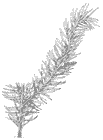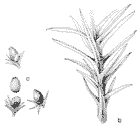Dacrydium xanthandrum
Pilger 1938
Common names
On Sabah: In Dusun and Sensuron it is called kerapui, in Bokan and Mt Alab seringoun, and it Atjeh it is arun gunong (de Laubenfels 1988).
Taxonomic notes
Description
"Shrub to tree, 2-36 m tall, up to 70 cm diam. Juvenile leaves spreading widely, bent slightly forward, linear-lanceolate, up to 2 cm long, 0.8 mm wide, strongly keeled on the dorsal side, slightly keeled and slightly convex on the axial side, about 0.2 mm thick, apiculate. Adult leaves spreading widely, straight or slightly bent forward but the tips still directed outwards, lanceolate to linear-lanceolate, 6-10 mm long or shorter at the base of the shoot, apiculate, strongly keeled on the dorsal side, slightly keeled and slightly concave on the axial side, 0.5-0.8 mm wide, 0.2 mm thick. Fertile stuctures both terminal and lateral. Pollen cone subtended by a cluster of reduced leaves which are c. 2 mm long, cone 5-13 mm long and 2-2.5 mm diam.; apex of the microsporophyll a lanceolate spur 0.6-1.2 mm long and 0.3 mm wide at the base. Seed-bearing structure subtended by a shoot up to 4 mm long with reduced leaves c. 2 mm long or when terminal sometimes following normal leaves; fertile bracts similar to leaves, spreading, 2-3 mm long; the shiny brown seeds c. 4 mm long, fully exposed, often in pairs" (de Laubenfels 1988).
"See comments under D. beccarii. The distinctly bifacially flattened leaves, generally concave on the axial surface, contrast strongly with the fine and distinctly more crowded leaves of D. beccarii. The difference is particularly noticeable on young plants. Fertile structures, like new shoots, are normally produced as is usual in the family after a period of rest but the examples of terminal seed-bearing structures without the usual subtending short shoot with reduced leaves apparently have appeared without the intervening rest period" (de Laubenfels 1988).
Distribution and Ecology
Solomon Islands (Bougainville); New Guinea (incl. New Britain); Central E. Celebes; Philippines (Mindoro); Borneo (Sabah; Central Kalimantan: Bt. Raya; Sarawak: Mt Mulu, Mt Murud); N. Sumatra (Atjeh); Malaya. Elevations range from (500-)1000-2700 m (de Laubenfels 1988). Within its range, mean annual temperature is 22.9°C, with an average minimum in the coldest month of 18.0°C, and a mean annual precipitation of 2911 mm (Biffin et al. 2011, Table S5). Its distribution is discontinuous; the tree is "locally common or even dominant and shrubby on mossy ridges with peaty soils over clay, sand, granite, sandstone, or dacite, or scattered larger individuals in nearby primary forest" (de Laubenfels 1988).
Remarkable Specimens
No data as of 2023.02.21.
Ethnobotany
No data as of 2023.02.21.
Observations
No data as of 2023.02.21.
Remarks
The epithet is from the Greek for "yellow" and "male", referring to the pollen cones.
See also
Dallimore et al. 1967.
Engl. Jahrb. (1938) 69, 252.
Gaussen, Gymn. Act. & Foss. fasc. 13, ch. 20 (1974) 34, f. 683.
de Laubenfels 1969.




